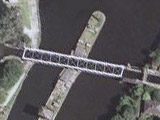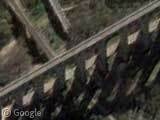Pontcysyllte Aqueduct
Tuesday, 7th July 2009 by Alex Turnbull
This is the Pontcysyllte Aqueduct, or to give it its full Welsh name, Traphont Ddŵr Pontcysyllte1, which carries the Llangollen Canal over the valley of the River Dee in north east Wales, and which has recently been recognised as one of the most important engineering accomplishments of all time.
Completed over 200 years ago, this stunningly beautiful engineering masterpiece was designed by everyone's favourite2 civil engineer Thomas Telford (1757 - 1834), and to this day it remains the longest and highest aqueduct in the UK.
Despite scepticism at the time (this was the late 1700s after all), Telford was convinced he could build a cast iron trough to carry the canal over the massive 307 metre span of the valley. After all, he had seen his methods succeed at Longdon-on-Tern, where he had designed the world's first cast iron navigable aqueduct.
Originally constructed as part of the now long-abandoned Shrewsbury Canal, today the Longdon-on-Tern aqueduct still sits astride the River Tern, and is not only Grade I listed but is also a scheduled ancient monument.
Despite this previous experience, the Pontcysyllte Aqueduct is truly a testament to Telford's genius. The cast iron trough he designed soars 38 metres above the valley floor, regularly carrying narrowboats safely3 over the valley.
In ultimate recognition of its importance, on the 27th of June 2009, the Pontcysyllte Aqueduct became a UNESCO World Heritage Site, joining a list of nearly 900 other places of great cultural or physical significance that includes such treasures as the Taj Mahal, the Great Wall of China, and Stonehenge.
Thanks to the ever on-the-ball Jonathan Rawle. See the Wikipedia links in this article for more info, or explore Wikipedia's list of works by Thomas Telford.
-
How glad am I that I don't have to try and say that out loud? ↩︎
-
Well he's everyone's favourite where I live, as we're very proud of Scotland's most famous bridge-building son.4 ↩︎
-
Assuming you don't fall off of course - there is no guard rail at all on the canal side! ↩︎
-
Granted, you may be more familiar with the work of John Rennie or Sir William Arrol, but surely neither has a name as widely known as Telford's? ↩︎








probably the only ‘map’ with rivers having a ‘cross-roads’ pattern google wont make a symbol for that 😉
Not true Peter, there are lots of water “crossroads”, for example:
https://www.googlesightseeing.com/2007/09/26/a-canal-across-germany/
Seems like it’s a tourist attraction these days where presumably it was originally intended for cargo or other deliveries.
At the start of the 20th century, small commercial canals like this were made obsolete by roads, and many of the UK’s canals fell into total decay during this period.
It was only thanks to the birth of the canal leisure industry in the latter part of the century that any like this survive at all. In the 70s canals were restored by volunteers, and today “there are more boats on the canals than at the height of the use of canals for commercial purposes”.
http://en.wikipedia.org/wiki/History_of_the_British_canal_system
Alex – just in case you ever do have to say it out loud, that’s “Traffont Thoor* Pont-kuh-SUTH-teh”. Roughly. The double L is the tricky part – if you have to wipe your chin afterwards then you’re doing it right 😉
Mae flin ‘da fi, ond… Sorry to say so, but phonetic transliterations from Welsh don’t work, as you are bound to get the emphasis in the wrong place and the sounds you transcribed are just plain wrong. For many centuries, Welsh was spelled phonetically using the English alphabet and sound set as a basis, but adapting it where necessary. That they keep the doubled consonants and mutation elision of consonant pairs is deliberate, because the sounds are recognisably different – they were pushed to change, but have good reasons in the language not to do so. To take that transcription of the w in dwr as oo, for example: it’s actually more like oouw, depending on the region you’re from a bit. The ph is a mutated p resulting from the concatenation of tra – crossing – and pont – bridge, which results in a sound with a hint of a v in it, the ph doing its best to become an f which is pronounced as a hard v, but in either case a certain distance from the soft ff you propose. You’d do better to point Alex in the direction of a decent Welsh pronouncer.
Mae’n ddrwg gen i ond…
What Jel says makes no more sense than suggesting “th” for “ll”. It comes from someone who obviously knows nothing about Welsh phonetics and apparently does not speak Welsh (as you can tell from his very first sentence). Ignore it.
Where should you park if you are going to visit the Aqueduct?